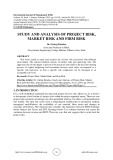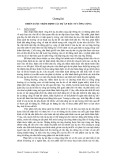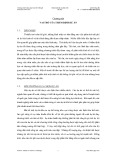
Chapter 27
The Basic Tools of Finance
TRUE/FALSE
1. If the interest rate is 8 percent, then the present value of $1,000 to be received in 4 years is $735.03.
ANS: T DIF: 2 REF: 27-1
NAT: Analytic LOC: The Study of economics, and definitions of economics
TOP: Present value MSC: Applicative
2. If a savings account pays 5 percent annual interest, then the rule of 70 tells us that the account value will
double in approximately 14 years.
ANS: T DIF: 2 REF: 27-1
NAT: Analytic LOC: The Study of economics, and definitions of economics
TOP: Compounding MSC: Applicative
3. The present value of $100 to be paid in two years is less than the present value of $100 to be paid in three
years.
ANS: F DIF: 1 REF: 27-1
NAT: Analytic LOC: The Study of economics, and definitions of economics
TOP: Present value MSC: Analytic
4. The future value of $1 saved today is $1/(1 + r).
ANS: F DIF: 1 REF: 27-1
NAT: Analytic LOC: The Study of economics, and definitions of economics
TOP: Present value MSC: Analytical
5. The present value of any future sum of money is the amount that would be needed today, at current interest
rates, to produce that future sum.
ANS: T DIF: 1 REF: 27-1
NAT: Analytic LOC: The Study of economics, and definitions of economics
TOP: Present value MSC: Interpretive
6. The sooner a payment is received and the higher the interest rate, the greater the present value of a future
payment.
ANS: F DIF: 1 REF: 27-1
NAT: Analytic LOC: The Study of economics, and definitions of economics
TOP: Present value MSC: Analytical
7. A company that can build a project that will cost $50,000, but returns $52,000 in one year would make a good
decision by turning this project down if the interest rate were 3 percent.
ANS: F DIF: 1 REF: 27-1
NAT: Analytic LOC: The Study of economics, and definitions of economics
TOP: Investment | Present value MSC: Analytical
8. As the interest rate increases, the present value of future sums decreases, so firms will find fewer investment
projects profitable.
ANS: T DIF: 1 REF: 27-1
NAT: Analytic LOC: The Study of economics, and definitions of economics
TOP: Investment | Present value MSC: Analytical
9. According to the rule of 70, if you earn an interest rate of 3.5 percent, your savings will double about every 20
years.
ANS: T DIF: 1 REF: 27-1
NAT: Analytic LOC: The Study of economics, and definitions of economics
TOP: Rule of 70 MSC: Definitional
19

20 Chapter 27/The Basic Tools of Finance
10. If you are faced with the choice of receiving $500 today or $800 6 years from today, you will be indifferent
between the two possibilities if the interest rate is 8.148 percent.
ANS: T DIF: 2 REF: 27-1
NAT: Analytic LOC: The Study of economics, and definitions of economics
TOP: Present value MSC: Applicative
11. Risk aversion simply means that people dislike bad things to happen.
ANS: F DIF: 1 REF: 27-2
NAT: Analytic LOC: The study of economics, and definitions of economics
TOP: Risk MSC: Interpretive
12. Risk-averse individuals like good things more than they dislike comparable bad things.
ANS: F DIF: 2 REF: 27-2
NAT: Analytic LOC: The Study of economics, and definitions of economics
TOP: Risk MSC: Interpretive
13. People who are risk averse dislike bad outcomes more than they like comparable good outcomes.
ANS: T DIF: 2 REF: 27-2
NAT: Analytic LOC: Utility and consumer choice TOP: Risk
MSC: Interpretive
14. The market for insurance is an example of diversification.
ANS: T DIF: 1 REF: 27-2
NAT: Analytic LOC: The Study of economics, and definitions of economics
TOP: Diversification MSC: Interpretive
15. A person’s subjective measure of well-being or satisfaction is called aversion.
ANS: F DIF: 2 REF: 27-2
NAT: Analytic LOC: The Study of economics, and definitions of economics
TOP: Utility MSC: Definitional
16. Historically, stocks have offered higher rates of return than bonds.
ANS: T DIF: 1 REF: 27-2
NAT: Analytic LOC: The Study of economics, and definitions of economics
TOP: Returns MSC: Definitional
17. Historically the return on stocks has been higher than the return on bonds. In part this reflects the higher risk
from holding stock.
ANS: T DIF: 2 REF: 27-2
NAT: Analytic LOC: The study of economics, and definitions of economics
TOP: Risk | Returns MSC: Definitional
18. Risk-averse persons will take no risks.
ANS: F DIF: 1 REF: 27-2
NAT: Analytic LOC: The Study of economics, and definitions of economics
TOP: Risk MSC: Interpretive
19. The market for insurance is one example of reducing risk by using diversification.
ANS: T DIF: 1 REF: 27-2
NAT: Analytic LOC: The Study of economics, and definitions of economics
TOP: Diversification | Insurance MSC: Definitional
20. A person with diminishing marginal utility of wealth is risk averse.
ANS: T DIF: 1 REF: 27-2
NAT: Analytic LOC: The Study of economics, and definitions of economics
TOP: Risk MSC: Definitional

Chapter 27/The Basic Tools of Finance 21
21. Adverse selection is illustrated by people who take greater risks after they purchase insurance.
ANS: F DIF: 1 REF: 27-2
NAT: Analytic LOC: The Study of economics, and definitions of economics
TOP: Adverse selection MSC: Interpretive
22. Increasing the number of corporations whose stocks are in your portfolio reduces market risk.
ANS: F DIF: 1 REF: 27-2
NAT: Analytic LOC: The Study of economics, and definitions of economics
TOP: Diversification | Risk MSC: Applicative
23. Diversification can reduce firm-specific risk.
ANS: T DIF: 1 REF: 27-2
NAT: Analytic LOC: The Study of economics, and definitions of economics
TOP: Diversification MSC: Applicative
24. According to fundamental analysis, when choosing stocks for your portfolio, you should prefer undervalued
stocks.
ANS: T DIF: 1 REF: 27-3
NAT: Analytic LOC: The Study of economics, and definitions of economics
TOP: Fundamental analysis MSC: Applicative
25. The value of a stock depends on the ability of the company to generate dividends and the expected price of the
stock when the stockholder sells her shares.
ANS: T DIF: 1 REF: 27-3
NAT: Analytic LOC: The Study of economics, and definitions of economics
TOP: Fundamental analysis MSC: Definitional
26. According to the efficient markets hypothesis, at any moment in time, the market price is the best estimate of
the company's value based on publicly available information.
ANS: T DIF: 1 REF: 27-3
NAT: Analytic LOC: The Study of economics, and definitions of economics
TOP: Efficient markets hypothesis MSC: Definitional
27. According to the efficient markets hypothesis, stocks follow a random walk so that stocks that increase in
price one year are more likely to increase than decrease in the next year.
ANS: F DIF: 1 REF: 27-3
NAT: Analytic LOC: The Study of economics, and definitions of economics
TOP: Random walk MSC: Definitional
28. According to the efficient markets hypothesis, the number of people who think a stock is overvalued exactly
balances the number of people who think a stock is undervalued.
ANS: T DIF: 2 REF: 27-3
NAT: Analytic LOC: The study of economics, and definitions of economics
TOP: Efficient markets hypothesis MSC: Definitional
29. Studies find that mutual fund managers who do well in one year, are likely to do well the next year.
ANS: F DIF: 2 REF: 27-3
NAT: Analytic LOC: The study of economics, and definitions of economics
TOP: Efficient markets hypothesis MSC: Definitional
30. Managed mutual funds usually outperform mutual funds that are supposed to follow some stock index.
ANS: F DIF: 1 REF: 27-3
NAT: Analytic LOC: The Study of economics, and definitions of economics
TOP: Index funds | Mutual funds MSC: Definitional

22 Chapter 27/The Basic Tools of Finance
31. Speculative bubbles may arise in part because the value of the stock to a stockholder depends on the final sale
price.
ANS: T DIF: 1 REF: 27-3
NAT: Analytic LOC: The Study of economics, and definitions of economics
TOP: Asset valuation MSC: Interpretive
32. Available evidence indicates that stock prices, even if not exactly a random walk, are very close to a random
walk.
ANS: T DIF: 2 REF: 27-3
NAT: Analytic LOC: The Study of economics, and definitions of economics
TOP: Random walk MSC: Interpretive
33. If you wish to rely on fundamental analysis to choose a portfolio of stocks, then you have no choice but to do
all the necessary research yourself.
ANS: F DIF: 2 REF: 27-3
NAT: Analytic LOC: The Study of economics, and definitions of economics
TOP: Fundamental analysis MSC: Interpretive
34. If you believe the stock market is informationally efficient, then it is a waste of time to engage in fundamental
analysis.
ANS: T DIF: 2 REF: 27-3
NAT: Analytic LOC: The Study of economics, and definitions of economics
TOP: Efficient markets hypothesis | Fundamental analysis MSC: Interpretive
SHORT ANSWER
1. Demonstrate that whether you would prefer to have $225 today or wait five years for $300 depends on the
interest rate. Show your work.
ANS:
For example at 3 percent the present value of $300 in five years is $300/(1.03)5 = $258.78 but at 7 percent the
present value of $300 in five years is $300/(1.07)5 = $213.90.
DIF: 2 REF: 27-1 NAT: Analytic
LOC: The Study of economics, and definitions of economics TOP: Present value
MSC: Analytical
2. As the interest rate increases, what happens to the present value of a future payment? Explain why changes in
the interest rate will lead to changes in the quantity of loanable funds demanded and investment spending.
ANS:
An increase in the interest rate reduces the present value of future payments. Investment spending is the purchasing
of capital goods that are expected to raise future revenues. When interest rates rise, the present value of these future
revenues decline so that fewer capital expenditures are likely to generate enough revenue to justify their price.
Consequently firms will want to buy fewer capital goods and will demand a lower quantity of loanable funds.
DIF: 2 REF: 27-1 NAT: Analytic
LOC: The Study of economics, and definitions of economics TOP: Present value
MSC: Analytical
3. Write the rule of 70. Suppose that your great-great-grandmother put $50 in a savings account 100 years ago
and the account is now worth $1,600. Use the rule of 70 to determine about what interest rate she earned.
ANS:
$1,600/$50 = 32. The rule of 70 says that if X is the growth rate of a variable, then the variable doubles every 70/X
years. This implies the value of the stock doubled five times. Since it doubled 5 times in 100 years, it doubled every
20 years. According to the rule of 70, the value of an asset doubles every 70/X years. So, we need 70/X = 20, which
means that X is 3.5 percent.
DIF: 3 REF: 27-1 NAT: Analytic
LOC: The Study of economics, and definitions of economics TOP: Rule of 70
MSC: Analytical

Chapter 27/The Basic Tools of Finance 23
4. Give an example of adverse selection and an example of moral hazard using homeowners insurance.
ANS:
An example of adverse selection is that someone whose home is in a location prone to theft is more likely to apply
for homeowners insurance. An example of moral hazard is that once someone has insurance, he might keep fewer
fire extinguishers in the house.
DIF: 1 REF: 27-2 NAT: Analytic
LOC: The Study of economics, and definitions of economics
TOP: Adverse selection | Moral hazard MSC: Interpretive
5. What's the difference between firm-specific risk and market risk? Will diversification eliminate one or both?
Explain.
ANS:
Market risk refers to economywide risk created by variations in output. Firms in general have lower sales and profits
when output falls. Because all firms are likely to suffer through the downturn, market risk cannot be eliminated by
diversification. Firm specific risk is specific to firms or industries and not the entire economy. Since some changes
will be good for one industry and bad for another, diversification can reduce firm-specific risk but not market risk.
DIF: 2 REF: 27-2 NAT: Analytic
LOC: The Study of economics, and definitions of economics TOP: Risk
MSC: Definitional
6. List three different ways that a risk-averse person can reduce financial risk.
ANS:
A risk-averse person can reduce risk by buying insurance, by diversifying her stock portfolio, and by holding a
larger percentage of her assets as low risk and low return assets such as government securities.
DIF: 2 REF: 27-2 NAT: Analytic
LOC: The Study of economics, and definitions of economics TOP: Risk
MSC: Interpretive
7. Discuss the statistical evidence concerning the efficient markets hypothesis.
ANS:
The evidence indicates that stock prices may not follow a random walk exactly, but they are pretty close. The
correlation between how well a stock does one year and how well it does the next is close to zero. Indexed funds
tend to perform better than most managed funds. However, there is some evidence that people may become
overconfident in their abilities and this may lead to the overvaluation of stocks.
DIF: 3 REF: 27-3 NAT: Analytic
LOC: The Study of economics, and definitions of economics TOP: Efficient markets hypothesis
MSC: Definitional
8. In the 1990s, several stocks had very, very high price to earnings ratios. These stocks appeared overvalued to
many observers. What might the people who bought them have been thinking?
ANS:
There are several possibilities. The first is that they had very high expectations for corporations that weren't doing
well at the time to do very well in the future. The second is that in evaluating the value of stocks they took into
account what others might be willing to pay for them in the future. Even if they thought that the corporation might
never be profitable, they might have believed that other people would be willing to pay a lot for it in the future.
Another possibility is that people became overconfident in their ability to pick stocks in a rising stock market. This
overconfidence may have led buyers to bid up prices.
DIF: 3 REF: 27-3 NAT: Analytic
LOC: The Study of economics, and definitions of economics TOP: Asset valuation
MSC: Analytical


























